1998 HONDA ODYSSEY engine overheat
[x] Cancel search: engine overheatPage 156 of 272
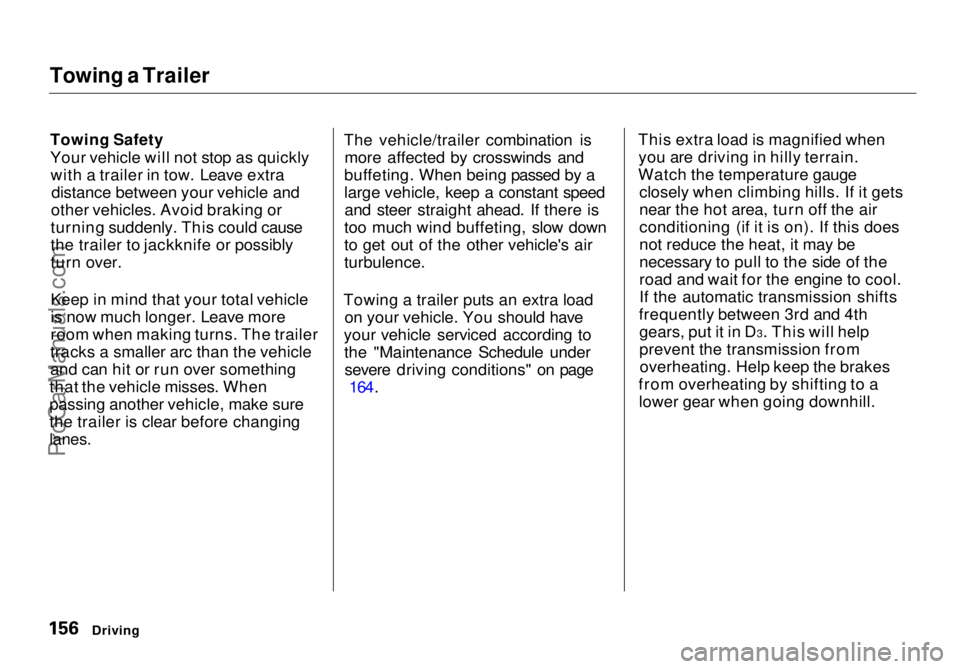
Towing a Trailer
Towing Safety
Your vehicle will not stop as quicklywith a trailer in tow. Leave extra distance between your vehicle and
other vehicles. Avoid braking or
turning suddenly. This could cause
the trailer to jackknife or possibly
turn over.
Keep in mind that your total vehicle
is now much longer. Leave more
room when making turns. The trailer
tracks a smaller arc than the vehicle
and can hit or run over something
that the vehicle misses. When
passing another vehicle, make sure
the trailer is clear before changing
lanes.
The vehicle/trailer combination is
more affected by crosswinds and
buffeting. When being passed by a
large vehicle, keep a constant speed and steer straight ahead. If there is
too much wind buffeting, slow down
to get out of the other vehicle's air
turbulence.
Towing a trailer puts an extra load on your vehicle. You should have
your vehicle serviced according to the "Maintenance Schedule undersevere driving conditions" on page 164. This extra load is magnified when
you are driving in hilly terrain.
Watch the temperature gauge closely when climbing hills. If it gets
near the hot area, turn off the air
conditioning (if it is on). If this does
not reduce the heat, it may be
necessary to pull to the side of the
road and wait for the engine to cool.
If the automatic transmission shifts
frequently between 3rd and 4th gears, put it in D3. This will help
prevent the transmission fromoverheating. Help keep the brakes
from overheating by shifting to a lower gear when going downhill.
DrivingProCarManuals.comMain Menu Table of Contents s t
Page 187 of 272
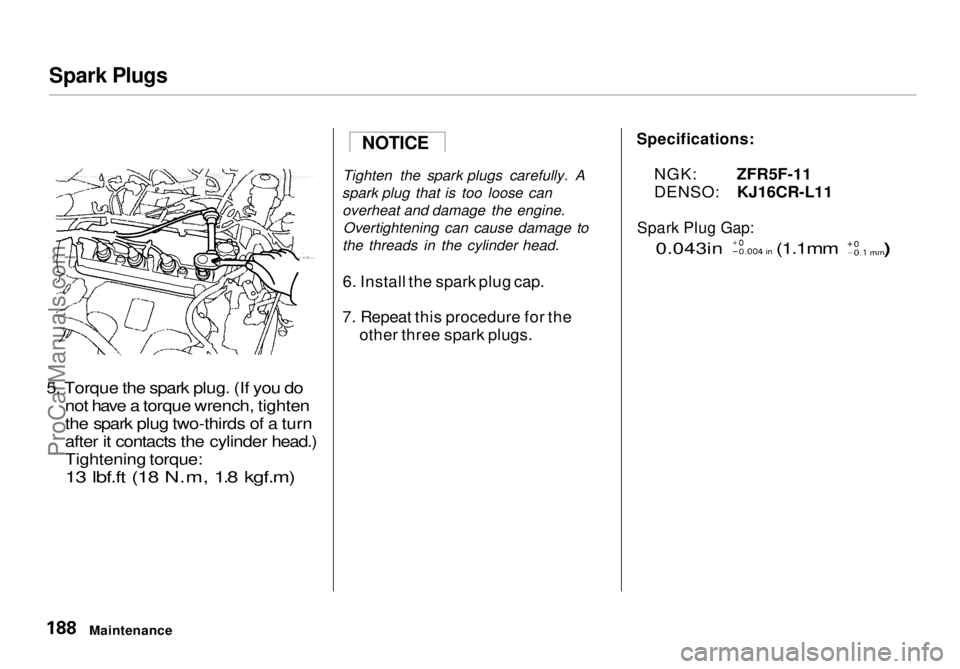
Spark Plugs
5. Torque the spark plug. (If you do not have a torque wrench, tighten
the spark plug two-thirds of a turn
after it contacts the cylinder head.)
Tightening torque:13 lbf.ft (18 N.m, 1.8 kgf.m)
Tighten the spark plugs
carefully. A
spark plug that is too loose can overheat and damage the engine. Overtightening can cause damage to
the threads in the cylinder head.
6. Install the spark plug cap.
7. Repeat this procedure for the other three spark plugs.
Maintenance
NOTICE
Specifications:
NGK: ZFR5F-11
DENSO: KJ16CR-L11
Spark Plug Gap:
0.043in
(1.1mm )ProCarManuals.comMain Menu Table of Contents s t
Page 218 of 272
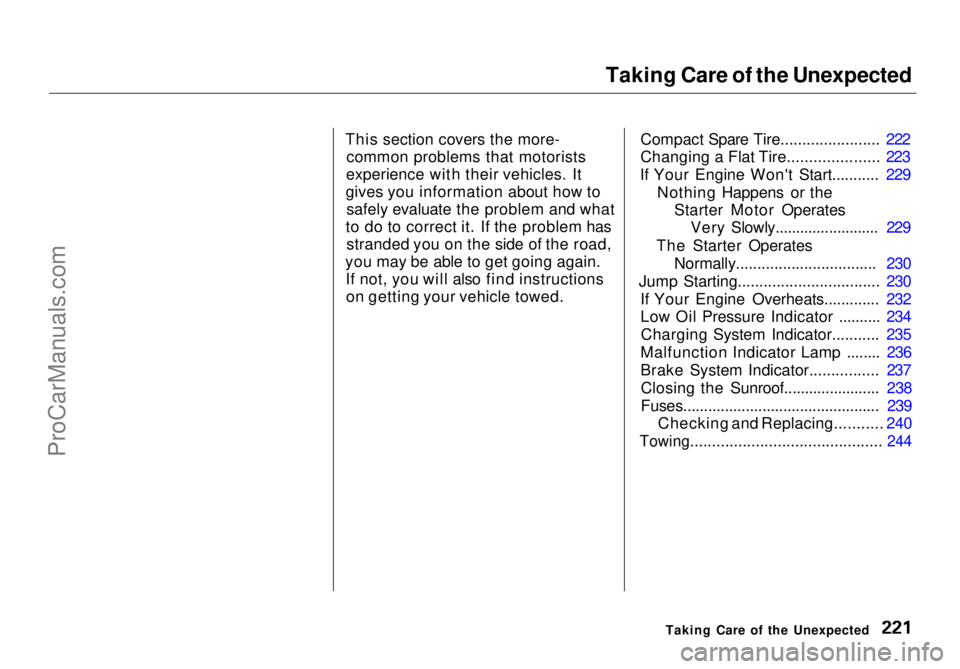
Taking Care of the Unexpected
This section covers the more- common problems that motorists
experience with their vehicles. It
gives you information about how to safely evaluate the problem and what
to do to correct it. If the problem has stranded you on the side of the road,
you may be able to get going again. If not, you will also find instructionson getting your vehicle towed. Compact Spare Tire....................... 222
Changing a Flat Tire..................... 223
If Your Engine Won't Start........... 229 Nothing Happens or theStarter Motor OperatesVery Slowly......................... 229
The Starter Operates Normally................................. 230
Jump Starting................................. 230 If Your Engine Overheats............. 232
Low Oil Pressure Indicator .......... 234Charging System Indicator........... 235
Malfunction Indicator Lamp ........ 236
Brake System Indicator................ 237 Closing the Sunroof....................... 238
Fuses............................................... 239 Checking and Replacing........... 240
Towing............................................ 244
Taking Care of the UnexpectedProCarManuals.comMain Menu s t
Page 229 of 272
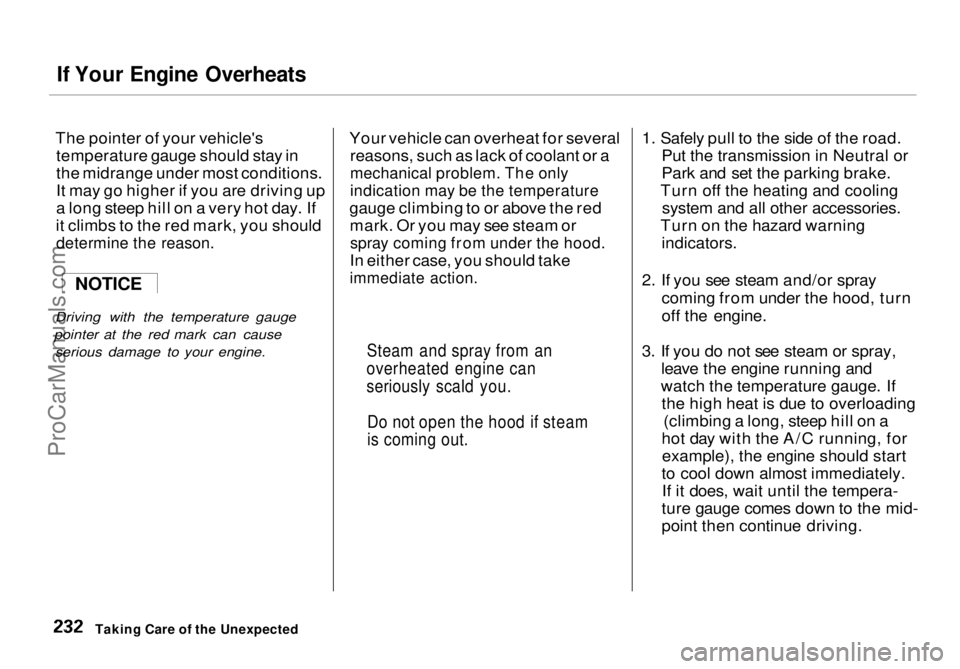
If Your Engine Overheats
The pointer of your vehicle's temperature gauge should stay in
the midrange under most conditions.
It may go higher if you are driving up
a long steep hill on a very hot day. If
it climbs to the red mark, you should
determine the reason.
Driving with the temperature gauge
pointer at the red mark can cause serious damage to your engine.
Your vehicle can overheat for several
reasons, such as lack of coolant or a
mechanical problem. The only
indication may be the temperature
gauge climbing to or above the red mark. Or you may see steam or
spray coming from under the hood.
In either case, you should take
immediate action.
1. Safely pull to the side of the road.
Put the transmission in Neutral or
Park and set the parking brake.
Turn off the heating and cooling system and all other accessories.
Turn on the hazard warning indicators.
2. If you see steam and/or spray coming from under the hood, turn
off the engine.
3. If you do not see steam or spray, leave the engine running and
watch the temperature gauge. If the high heat is due to overloading (climbing a long, steep hill on a
hot day with the A/C running, for example), the engine should start
to cool down almost immediately. If it does, wait until the tempera-
ture gauge comes down to the mid-
point then continue driving.
Taking Care of the Unexpected
NOTICE
Steam and spray from an
overheated engine can
seriously scald you.
Do not open the hood if steam
is coming out.ProCarManuals.comMain Menu Table of Contents s t
Page 230 of 272
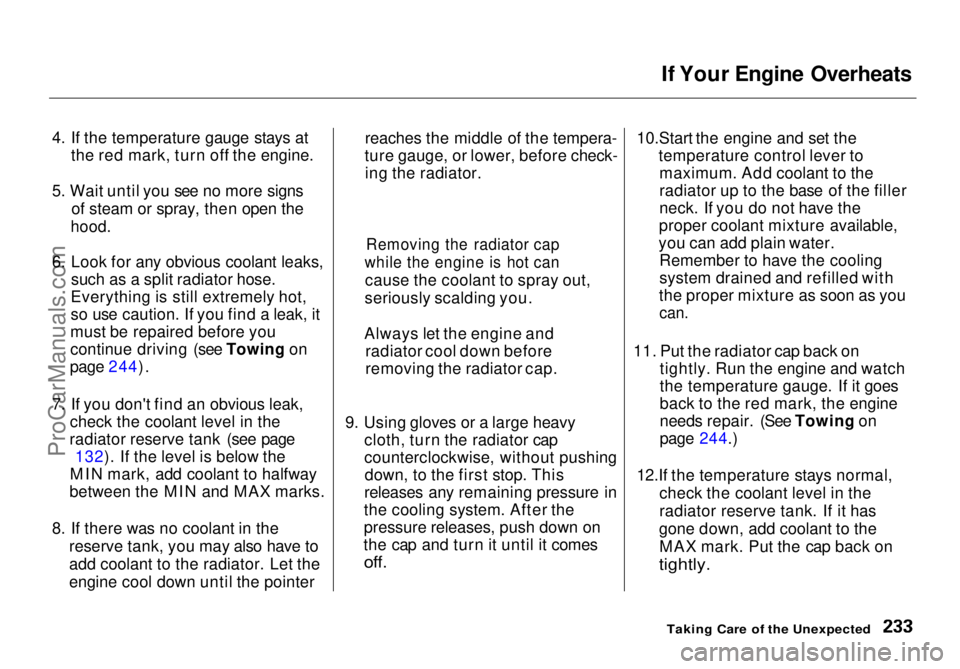
If Your Engine Overheats
4. If the temperature gauge stays at the red mark, turn off the engine.
5. Wait until you see no more signs of steam or spray, then open the
hood.
6. Look for any obvious coolant leaks, such as a split radiator hose.
Everything is still extremely hot,
so use caution. If you find a leak, it
must be repaired before you
continue driving (see Towing on
page 244).
7. If you don't find an obvious leak, check the coolant level in the
radiator reserve tank (see page 132). If the level is below the
MIN mark, add coolant to halfway
between the MIN and MAX marks.
8. If there was no coolant in the reserve tank, you may also have to
add coolant to the radiator. Let the
engine cool down until the pointer reaches the middle of the tempera-
ture gauge, or lower, before check- ing the radiator.
9. Using gloves or a large heavy cloth, turn the radiator cap
counterclockwise, without pushingdown, to the first stop. This
releases any remaining pressure in
the cooling system. After the
pressure releases, push down on
the cap and turn it until it comes
off.
10.Start the engine and set the
temperature control lever tomaximum. Add coolant to the
radiator up to the base of the filler
neck. If you do not have the
proper coolant mixture available,
you can add plain water. Remember to have the cooling
system drained and refilled with
the proper mixture as soon as you
can.
11. Put the radiator cap back on tightly. Run the engine and watch
the temperature gauge. If it goes
back to the red mark, the engine
needs repair. (See Towing on
page 244.)
12.If the temperature stays normal, check the coolant level in the
radiator reserve tank. If it has
gone down, add coolant to the MAX mark. Put the cap back on
tightly.
Taking Care of the Unexpected
Removing the radiator cap
while the engine is hot can
cause the coolant to spray out,
seriously scalding you.
Always let the engine and radiator cool down before
removing the radiator cap.ProCarManuals.comMain Menu Table of Contents s t
Page 265 of 272
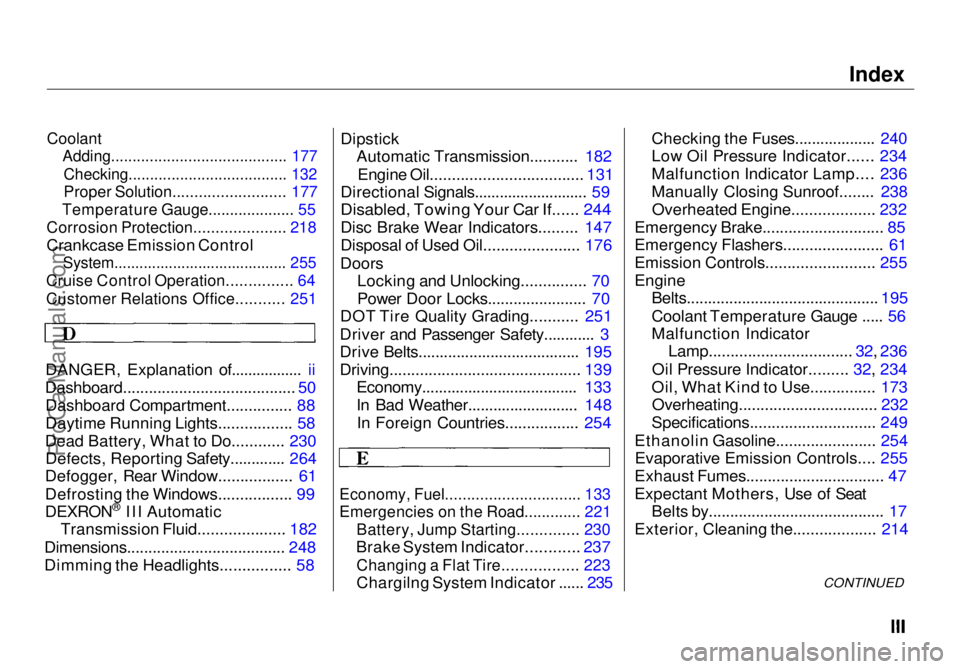
Index
Coolant
Adding......................................... 177
Checking..................................... 132
Proper Solution.......................... 177
Temperature Gauge.................... 55
Corrosion Protection..................... 218
Crankcase Emission Control
System......................................... 255
Cruise Control Operation............... 64
Customer Relations Office........... 251
DANGER, Explanation of................. ii
Dashboard........................................ 50 Dashboard Compartment............... 88
Daytime Running Lights................. 58
Dead Battery, What to Do............ 230 Defects, Reporting Safety............. 264
Defogger, Rear Window................. 61
Defrosting the Windows................. 99
DEXRON ®
III Automatic
Transmission Fluid.................... 182
Dimensions..................................... 248
Dimming the Headlights................ 58 Dipstick
Automatic Transmission........... 182
Engine Oil................................... 131
Directional Signals........................... 59
Disabled, Towing Your Car If...... 244
Disc Brake Wear Indicators......... 147
Disposal of Used Oil...................... 176
Doors Locking and Unlocking............... 70
Power Door Locks....................... 70
DOT Tire Quality Grading........... 251
Driver and Passenger Safety............ 3
Drive Belts...................................... 195
Driving............................................ 139 Economy..................................... 133
In Bad Weather.......................... 148
In Foreign Countries................. 254
Economy, Fuel............................... 133
Emergencies on the Road............. 221
Battery, Jump Starting.............. 230
Brake System Indicator............ 237
Changing a Flat Tire................. 223
Chargilng System Indicator ...... 235 Checking the Fuses................... 240
Low Oil Pressure Indicator...... 234
Malfunction Indicator Lamp.... 236
Manually Closing Sunroof........ 238
Overheated Engine................... 232
Emergency Brake............................ 85
Emergency Flashers....................... 61
Emission Controls......................... 255
Engine Belts............................................. 195
Coolant Temperature Gauge ..... 56
Malfunction IndicatorLamp................................. 32, 236
Oil Pressure Indicator......... 32, 234
Oil, What Kind to Use............... 173 Overheating................................ 232
Specifications............................. 249
Ethanolin Gasoline....................... 254 Evaporative Emission Controls.... 255
Exhaust Fumes................................ 47
Expectant Mothers, Use of Seat Belts by......................................... 17
Exterior, Cleaning the................... 214
CONTINUEDProCarManuals.comMain Menu s t
Page 268 of 272

Index
Octane Requirement, Gasoline.... 128
Odometer.......................................... 55
Odometer, Trip................................ 54
Oil Change, How to ......................... 175
Change, When to....................... 164
Checking Engine....................... 131
Pressure Indicator............... 52, 234
Selecting Proper Viscosity
Chart....................................... 174
ON (Ignition Key Position)............ 70
Opening the Hood......................... 130
Operation in Foreign Countries... 254
Outside Mirrors............................... 84
Overheating, Engine..................... 232
Owner Maintenance Checks........ 171
Panel Brightness Control............... 59
Park Gear Position......................... 143
Parking............................................ 146
Parking Brake.................................. 85
Parking Lights.................................. 58
Parking Over Things that Burn... 257
PGM-FI System.............................. 256
Polishing and Waxing................... 215
Power
Door Locks................................... 70
Mirrors.......................................... 84
Steering....................................... 184
Windows....................................... 82
Pre-Drive Safety Checklist............... 9
Pregnancy, Using Seat Belts.......... 17
Protecting Adults............................. 10
Additional Safety Precautions.... 17
Advice for Pregnant Women...... 17
Protecting Children......................... 19 Protecting Infants........................ 27
Protecting Larger Children........ 35
Protecting Small Children.......... 31
Using Child Seats withTethers...................................... 38
Radiator Overheating.................... 232
Radio/Cassette Sound System .... 103
Rear A/C Unit................................ 102
Rear End Towing........................... 244
Rear Lights, Bulb Replacement... 208
Rear View Mirror............................. 84
Rear Window Defogger.................. 62
Rear Window Wiper and Washer.. 61
Reclining the Seat Backs................ 75
Reclining the Second Seats............ 79 Reminder Lights.............................. 51
Remote Transmitter........................ 71 Removing the Second Seats........... 78
Replacement Information Air Cleaner Element.................. 185
Coolant........................................ 179
Engine Oil and Filter................. 175
Fuses........................................... 240
Light Bulbs................................. 206
Schedule..................................... 162
Spark Plugs................................. 187
Timing Belt................................. 195
Tires............................................ 199
Wiper Blades.............................. 191
Replacing Seat Belts After a Crash............................................. 43
Reserve Tank, Coolant.................. 132 Restraint, Child................................ 19
Reverse Gear Position................... 143
Rotation, Tire................................. 199ProCarManuals.comMain Menu s t